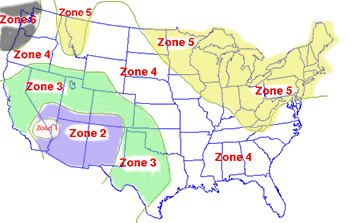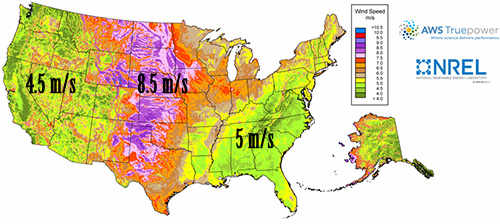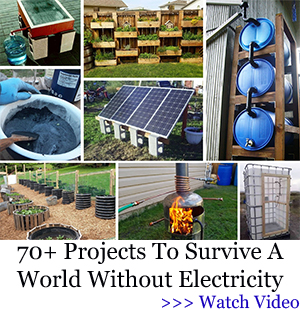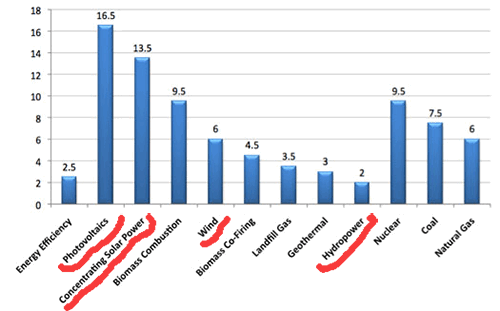In the picture: Lakewood, Colorado House – built in 1956. Brent and Nelson upgraded the home with multiple solar technologies including; daylighting, passive solar and active solar. They also have an 80 gallon solar hot water heater. | Photo by Dennis Schroeder, National Renewable Energy Laboratory.
It takes one solar panel a day in the sun to produce a single kilowatt hour of electricity. A kilowatt hour that you’ll consume in about 50 minutes with a microwave oven, or with a 40-watt light bulb operating for 25 hours, or with a 1KW heater operating for one hour, or five hours with a television.
On average we consume 29.8 kilowatt hour/day (in the US).
The bad news is that no matter how it works out or what option do you choose to produce your own electricity, you’ll never again take a kilowatt hour for granted.
The good news is that you can get off the grid even if you don’t have a fortune to spend on power equipment. But you’ll probably have to abstain from having an air conditioner or a dishwasher. In addition to this, you can cook and heat the house and water with wood stoves (if you want to invest even less in power equipment).
Our lives and our society have become so dependent on the grid that separating ourselves from it requires us to radically change our lifestyle. But while the grid is big and “confortable” it is also very fragile to severe weather (especially hurricanes) and attacks. Basically almost all SHTF events may cripple the power grid.
Related: “I Powered my House During and After Hurricane Sandy.” – Learn How
Getting Off the Grid with Solar Power:
The efficiency of Solar Power depends on a series of factors like: the place and the position of your solar panels, the geographical location (see map below), weather, and so on.
If you want to go completely off the grid with solar power you’ll find out that the initial investment is pretty high. If you manage to cut the consumption to 10 kilowatt hour/day you’ll need 10 solar panels, an inverter and battery storage (30 Kwh storage – 3 days) which can be an investment of $25,000 up to $50,000. An investment that you’ll recover in 20 years – 40 years (depending on the evolution of grid electricity prices, the company you choose to buy from, the system that you buy, inflation, and so on).
How Many Sun Hours a Day Do You Get?
 Zone 1 6 hours
Zone 1 6 hours
Zone 2 5.5 hours
Zone 3 5 hours
Zone 4 4.5 hours
Zone 5 4.2 hours
Zone 6 3.5 hours (Source)
But if you invest in a solar off the grid powering system there are federal tax credits to lower your upfront costs. The federal solar Investment Tax Credit (ITC) is a 30 percent tax credit and it is valid by the end of 2016.
Local tax incentives vary by state and municipality. For example Los Angeles residents can take the ITC, then receive a property tax exemption from the state of California as well as a rebate of $0.12 per kilowatt-hour for 20 years from the city of L.A. It’s worth doing your due diligence to make sure you’re taking advantage of all the financial help that’s available to you. (Source) Here are the solar incentives by state.
Downside:
- Several decades for a positive return on the investment
- Dependent on the weather; cloudy and foggy days will produce electricity but probably not enough;
Related: Ultimate Energy Independence
Getting Off the Grid with Wind Power:
Windmills have been used for pumping water or grinding grain. Today, the windmill’s modern equivalent – a wind turbine – can generate electricity to power a small house.
Wind turbines have significant economies of scale. Smaller farm or residential scale turbines cost less overall, but are more expensive per kilowatt of energy producing capacity. Just like solar panels these have a 30 percent tax credit and other incentives that can dramatically reduce the cost of a project.
The purchase and installation of a system large enough to power an entire house costs around $10,000 but can go up to $40,000 – depending on several factors like consumption and average annual wind speed in your location. See map: You can buy wind turbines for under $1000 but don’t expect to power an entire house.
You can buy wind turbines for under $1000 but don’t expect to power an entire house.
Downside:
- Not cheap and wind dependent;
Related: 10 Things to Have Ready before the Huge EMP !!!
Getting Off the Grid with Hydro-Power:
Hydropower is the most used form of green energy worldwide for a good reason. Unlike solar panels (or wind energy) a hydropower system generates electricity 24/7, it’s more reliable and more efficient that all other green sources.
If you have water flowing through your property, you might consider building a small hydropower system to generate electricity. You’ll need to know your water rights and local permit requirements.
A single Micro Hydro Generator at a pretty good site can produce 25 kilowatt hour/day – enough electricity for a typical American house (average being 29.8 Kw/h as mentioned).
Here is an example of micro hydro generator that is around $ 1600. (Remember the price for solar panels?)
Downside:
- Not everyone has a river on their property (or access to a river)
Related: DIY Cost-effective Generator
Powering a House Using a (Portable) Generator:
These are typically powered with gas or fuel of some sort. A large size Portable Generator starts at $700 and can go up to $9000. Most run on gasoline and will power an entire house at the cost of fuel.
As long as you have fuel these generators are the most reliable. The initial investment is minimal but the operating costs are the highest (fuel). And of course: pollution.
Downside:
- High fuel costs
- Fuels availability in a crisis
- Fuel storage considerations
Related: DIY String Motor
Choosing the Perfect Plan to Go Off the Grid
In a crisis I think it would be enough to have ready one of these 4 means to produce electricity without investing a fortune in it. That would be in my opinion a decent level of preparedness. I’m thinking that if the SHTF, then we will use power for survival needs – a fridge, a radio, charging a phone… definitely less than 10Kwh/day.
But if you want to go completely off the grid and keep a decent level of comfort, I think the best option would be to have at least two means of producing electricity, including one that is very reliable.
You don’t want to pray for a sunny day to power up your fridge, or for the winds to blow in order to watch your favorite TV show.
So here are 3 good options:
1 – Solar panels with a back-up generator
2 – Wind turbine with a back-up generator
3 – or if you have a river nearby a very good option would be a mini hydro generator and only one back-up solar panel (1KWh/day) which you use just to store energy the whole year in a different battery. Energy that you’ll use only when in need, especially when there are droughts and you can’t get enough energy from the river. In an year the solar panel will store 365 KWh, energy that will be enough to power your house for a month even if the river is all dried up. See video below:
By the way I’m not advertising the micro hydro generator. It is just one of the good “hydro” options that you have. But there are many more including one DIY Water Wheel Electric Generator.
Here are the costs of producing electricity with various options:
Conclusion:
There is no general “best solution” to go off the grid. It all depends on the location you live in.
But the most cost-effective way to go off the grid is option 3 (hydro + one solar panel or a small wind turbine). I guess with batteries, wires, hydro-generator and all will get you around $4000 – $7000. Of course you can do that cheaper with a generator (on fuel) but you won’t slash your bills too much. Anyway, for preppers, (in case the grid goes down) or in case of an EMP – a back-up generator is probably the best option.
Related: DIY Back-up Generator
You may also like:
 Why Is FEMA Tracking Down Preppers? This Is How They Prepare For A Food Crisis
Why Is FEMA Tracking Down Preppers? This Is How They Prepare For A Food Crisis
This Homemade Device Can Power Up Your Entire House 7 Days in a Row (Video)
The Backyard Plant That Has Similar Effects To Xanax
Why You Should Put A Coin In A Cup Of Frozen Water In Your Freezer























as always very good aka GREAT info have a great 2019 bill & village gang.
What effect will an EMP have on a gas powererd generator that is outside.
There are at least several factors as to what effect an EMP will have on a gas-powered outside generator. First, you need to understand that there are 2 primary components of a backup generator–the engine and the alternator. the engine turns mechanical hardware in the alternator and it is the alternator that produces the AC electricity. Some important factors are:
The strength or amplitude of an EMP and the distance from the source position of the EMP and the amount of and kind of material that is between the generator and the source of the EMP. The most common EMP is a bolt of lightning. We all see lightning in thunderstorms all the time and yet it has no effect on our electrical/electronic devices; but if lightning is close enough, the bolt will temporarily knock out all power in the building for the duration of the pulse and fry some electrical devices. a bolt of lightning hit the maple tree in my front yard a few years ago and both my front and back yard was a ball of white light and my laptop, combination DVD/VCR recorder was completely fried along with a couple iof GFCI outlets.
To have hydro power, you have to have a steady flow of water. In the southwest, the steady flow of water is limited to areas around rivers, which are very few. Buying property along a river here is very expensive, almost to the point of being prohibited. In regions 1 and 2 the sun shines 8 to 12 hours a day during the summer and at 6 to 8 hours a day in winter. The intensity of the sunlight here is much stronger than any where else in the U.S. Also we don’t have the cloud cover that happens else where as well. So solar power is the way to go here and the authors’ calculation aren’t correct as to the amount of power that would be generated during the time of full sun. There are a lot of articles that put out info on the amount of power generated by solar panels, but most are authored by people that don’t live in the southwest. It would be nice to have accurate info for a change.
You spend over 1/2 of this post on hydroelectric power…when you yourself say that most don’t have access to rivers. I’d guess less than 99.9% of the population have that access. THEN you say it’s the best option?
WHY spend that much “information” on something that almost NO ONE HAS ACCESS TO???
Get real and give us a REAL post on powering an off grid house!!!